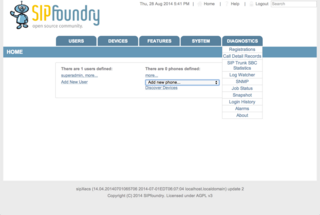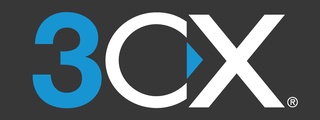Voice over Internet Protocol (VoIP), also called IP telephony, is a method and group of technologies for voice calls, the delivery of voice communication sessions over Internet Protocol (IP) networks, such as the Internet.
A softswitch is a call-switching node in a telecommunications network, based not on the specialized switching hardware of the traditional telephone exchange, but implemented in software running on a general-purpose computing platform. Like its traditional counterparts it connects telephone calls between subscribers or other switching systems across a telecommunication network. Often a softswitch is implemented to switch calls using voice over IP (VoIP) technologies, but hybrid systems exist.

Asterisk is a software implementation of a private branch exchange (PBX). In conjunction with suitable telephony hardware interfaces and network applications, Asterisk is used to establish and control telephone calls between telecommunication endpoints, such as customary telephone sets, destinations on the public switched telephone network (PSTN), and devices or services on voice over Internet Protocol (VoIP) networks. Its name comes from the asterisk (*) symbol for a signal used in dual-tone multi-frequency (DTMF) dialing.

A business telephone system is a multiline telephone system typically used in business environments, encompassing systems ranging in technology from the key telephone system (KTS) to the private branch exchange (PBX).
Direct inward dialing (DID), also called direct dial-in (DDI) in Europe and Oceania, is a telecommunication service offered by telephone companies to subscribers who operate a private branch exchange (PBX) system. The feature provides service for multiple telephone numbers over one or more analog or digital physical circuits to the PBX, and transmits the dialed telephone number to the PBX so that a PBX extension is directly accessible for an outside caller, possibly by-passing an auto-attendant.

Skype for Business Server is real-time communications server software that provides the infrastructure for enterprise instant messaging, presence, VoIP, ad hoc and structured conferences and PSTN connectivity through a third-party gateway or SIP trunk. These features are available within an organization, between organizations and with external users on the public internet or standard phones.

On analog telephone lines with special services, a flash or register-recall signal is used to control functions on the public telephone exchange, PBX or VoIP ATA.

SipXecs is a free software enterprise communications system.

Nortel Meridian is a private branch exchange telephone switching system. It provides advanced voice features, data connectivity, LAN communications, computer telephony integration (CTI), and information services for communication applications ranging from 60 to 80,000 lines.
Sipgate, stylised as sipgate, is a European VoIP and mobile telephony operator.
Mobile VoIP or simply mVoIP is an extension of mobility to a voice over IP network. Two types of communication are generally supported: cordless telephones using DECT or PCS protocols for short range or campus communications where all base stations are linked into the same LAN, and wider area communications using 3G or 4G protocols.

Microsoft Response Point was an advanced software-based telephone system developed by Microsoft. Response Point, a PBX system targeting small businesses with less than 50 employees, was launched in March 2007, with systems available on the market in the fourth quarter of that year. Response Point is VoIP-based, and uses SIP as its signaling and call setup protocol. Response Point supports voicemail and multi-party calling in addition to two party VoIP calls. Response Point features innovative voice recognition technology to manage calls and voice mail. Voicemail messages can, optionally, be sent to e-mail where they can be retrieved and archived. Response Point voice dialing can work with the Response Point phone directory which is currently limited to 1100 contacts per user. Contacts may be imported from the Windows Address Book or Microsoft Outlook. Response Point automatically detects gateways and phones connected to the network.
Unified communications (UC) is a business and marketing concept describing the integration of enterprise communication services such as instant messaging (chat), presence information, voice, mobility features, audio, web & video conferencing, fixed-mobile convergence (FMC), desktop sharing, data sharing, call control and speech recognition with non-real-time communication services such as unified messaging. UC is not necessarily a single product, but a set of products that provides a consistent unified user interface and user experience across multiple devices and media types.
TouchWave, Inc., was a privately held Palo Alto, California IP-telephony network switch provider founded in 1997. TouchWave developed a product line called WebSwitch that was designed to replace traditional private telephone exchange systems in small-to-medium-sized companies. WebSwitch was part of a phone system that incorporates communication features provided by the Internet. The rapid success of TouchWave was memorialized with awards and an acquisition by Ericsson Communications for $46M two years after TouchWave was founded. Ericsson continued the TouchWave product line under the name WebCom, but its efforts have been viewed as less than successful.
Nirvanix is an American-based provider of business phone systems, VoIP services, hosted PBX, SIP Trunks, and cloud storage services headquartered in San Diego, California, United States. The company offers a variety of business phone solutions for small, medium as well as enterprise businesses. It also has a strong presence in public, hybrid and private cloud storage services with usage-based pricing. Based on previous service companies founded in 1998, Nirvanix shut down in October 2013. In July 2021 Nirvanix re-entered the business with $12 million funding.
Iristel is a Canadian provider of telecommunication services that is a competitive local exchange carrier (CLEC). The company was founded in 1999 and is headquartered in Markham, Ontario.

The 3CXPhone System is the software-based private branch exchange (PBX) Phone system developed and marketed by the company, 3CX. The 3CX Phone System is based on the SIP standard and enables extensions to make calls via the public switched telephone network (PSTN) or via Voice over Internet Protocol (VoIP) services on premises, in the cloud, or via a cloud service owned and operated by the 3CX company. The 3CX Phone System is available for Windows, Linux, Raspberry Pi and supports standard SIP soft/hard phones, VoIP services, faxing, voice and web meetings, as well as traditional PSTN phone lines.
Cloud communications are Internet-based voice and data communications where telecommunications applications, switching and storage are hosted by a third-party outside of the organization using them, and they are accessed over the public Internet. Cloud services is a broad term, referring primarily to data-center-hosted services that are run and accessed over an Internet infrastructure. Until recently, these services have been data-centric, but with the evolution of VoIP, voice has become part of the cloud phenomenon. Cloud telephony refers specifically to voice services and more specifically the replacement of conventional business telephone equipment, such as a private branch exchange (PBX), with third-party VoIP service.
Dialexia Communications, Inc. is a privately held Canadian corporation headquartered in Montréal, Quebec, that develops, manufactures, and sells VoIP-based Telecommunication products and services. The company specializes in the development of webRTC-enabled PBX software for organizations in specific sectors of activity, notably education & hospitality. Dialexia software enables users to connect multiple phones, share lines among several phones and implement business PBX telephone phone features such as voicemail, caller ID, call forwarding & call recording into their virtual PBX.







